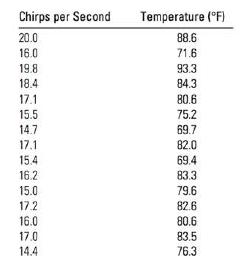12.24 Cricket (the insect, not the game) Crickets make their chirping sounds by rapidly sliding one wing
Question:
12.24 Cricket (the insect, not the game) Crickets make their chirping sounds by rapidly sliding one wing over the other. The faster they move their wings, the higher the chirping sound that is produced. Scientists have noticed that crickets move their wings faster in warm temperatures than in cold temperatures. Therefore, by listening to the pitch of the chirp of crickets, it is possible to tell the temperature of the air. In a 1948 book called The Song of Insects, George W. Pierce, a Harvard physics professor, presented real data relating the number of chirps per second for striped ground crickets to the temperature in degrees Fahrenheit. Apparently the number of chirps represents some kind of average since it is given to the nearest tenth. The table below gives the recorded pitch (in vibra- tions per second) of a cricket chirping recorded at 15 different temperatures. The variables are chirps (the number of chirps per second) and temperature (the temperature in degrees Fahrenheit).

a. Convert the temperature from Fahrenheit to Celsius by using the formula C/5= (F-32)/9.
b. If you want to estimate the number of chirps per second based on the temperature, which variable is the response variable and which is the independent predictor variable?
c. Assume that there is a linear regression between temperature (in Celsius) and chirps. Calculate the least-squares regression line describing number of chirps as a linear function of temperature.
d. Plot the data points and regression line. Does it appear that the line fits the data?
e. Use the appropriate statistical tests and measures to explain the usefulness of the regression model for predicting number of chirps.
Step by Step Answer:

Introduction To Probability And Statistics
ISBN: 9780176509804
3rd Edition
Authors: William Mendenhall





